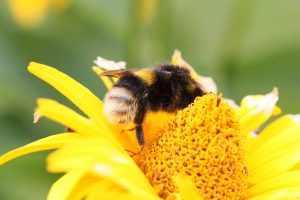THE INTELLIGENCE OF BEES

Did you know? Every third bite at the dinner table is thanks to bees! Bees are critical to the environment and food chain; they sustain entire ecosystems. In Canada, they are particularly important as they remain the number one pollinator in the country – for both crops and plants. In fact, almost all of the world’s plants need bees for cross-pollination – their very existence depends on it. As if this were not enough motivation to fight for the survival of the bee, researchers have found yet another reason: their exceptional intelligence, similar – in many ways – to human intelligence.
Bees, like humans, possess ‘collective intelligence’. This is social in nature and can be defined as a type of group decision making. Bees, like humans, copy one another – passing on information from others. There is one difference, however. Bees have the flexibility to stop ‘fake’ news from going viral in a colony. If a bee receives a message from another bee which does not match its personal experience, the information does not get passed on (Toyokawa, 2019). In human behaviour, however, a form of ‘collective madness’ tends to take over where information, despite being knowingly incorrect, continues to get transmitted. Toyokawa (2019) refers to this as maladaptive herding behaviour. How is it possible that a bee with a brain the size of a pinhead and with no more than one million neurons can outsmart a human with 86 million neurons (RMIT, 2018)? Bees, unlike humans, communicate mainly through dance. There are a number of dances to choose from, of which three (at least) speak to the location of food: the figure eight dance, the round dance, and the sickle dance. Hadley (2018) describes the figure eight dance as a complex way to communicate both the direction and distance to a given foraging site. The round dance, on the other hand, is used to indicate food within reach of the hive – less than 50 meters away, with no direction. The sickle dance is similarly used when food is between 50 to 150 meters from the hive. If, however, the information is incorrect or a better foraging site is found, the bees will adapt their behaviour to fit the new circumstances – avoiding the herd mentality often found in humans.
Besides social intelligence, bees also have mathematical intelligence. Only a few non-vertebrae species have been able to master mathematical operations. Honeybees have just been added to that list thanks to a group of researchers who discovered that honeybees understand the concept of zero (RMIT, 2018). Considering it took humans thousands of years to conceptualize the idea of zero, this is a remarkable finding. The same researchers have recently found that honeybees can also count up to four and do simple addition and subtraction, albeit using symbolic colours (Howard et al., 2019). Their sesame-seed sized brains were able to apply long-term rules and use short-term working memory to solve basic mathematical problems. This complex operation is referred to as numerical cognition, attributed so far only to humans, primates, the African gray parrot, spiders, and pigeons (Howard et al., 2019). The reason bees are able to learn how to do math is believed to be linked to two factors (Saplakoglu, 2019). One relates to the complex processing of information bees undertake daily. The other is connected to the high level of neuroplasticity of a bee’s brain. At this point, it appears bees have the mathematical ability of an average four-year old.
These latest findings on the unusual collective and mathematical intelligence of bees have come as a surprise to humans, despite earlier suspicions. Charles Darwin, for example, recognized that the size of a being’s brain does not necessarily equate to its intelligence back in the late 19thcentury (Darwin, 1871). The ancient Egyptians believed bees to be divine, having come from the tears of Ra, the sun god, himself (Maderspacher, 2007). More importantly, the study of bees, itself, dates back millennia to ancient Greece where Aristotle first wrote of their sexuality. It is clear that bees have always been important to humankind. The argument to fight for their survival keeps growing stronger with time. Now that they are deemed ‘intelligent beings’ from which humans can learn, battle should be waged two-fold.
References
Darwin, C. (1871). The descent of man. London: Penguin Books.
Hadley, D. (2018). How honey bees communicate. Retrieved January 11, 2020 from https://www.thoughtco.com/how-honey-bees-communicate-1968098
Howard, S., Avargues-Weber, A., Garcia, J., Greentree, A., & Dyer, A. (2019). Numerical cognition in honeybees enables addition and subtraction. Science Advances, 5(2).
Madespacher, F. (2007). All the queen’s men. Current Biology, 17(6), 191-195.
RMIT University (2018). Bees understand the concept of zero. Science Daily. Retrieved January 11, 2020 from https://www.sciencedaily.com/releases/2018/06/180607141031.htm
Saplakoglu, Y. (2019). Bees can solve math problems that would stump the average toddler. Live Science. Retrieved January 12, 2020 from https://www.livescience.com/64699-bees-can-do-math.html
Toyokawa, W. (2019). What smart bees can teach humans about collective intelligence. Retrieved January 11, 2020 from https://phys.org/news/2019-01-smart-bees-humans-intelligence.html
Comprehension Questions
Vocabulary Exercises
Academic Writing Exercises
Contextual Grammar Exercises

